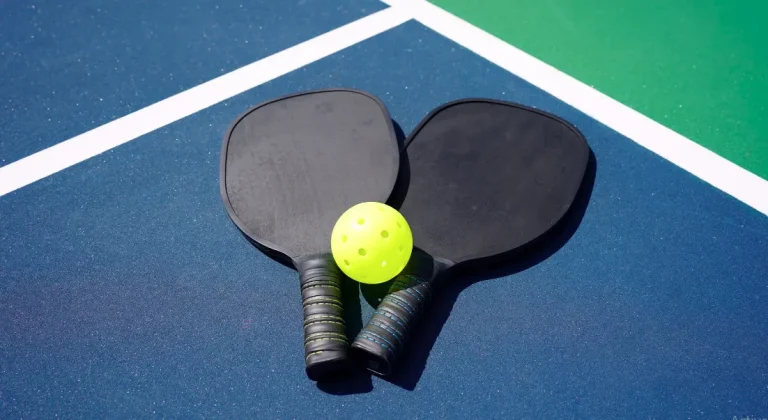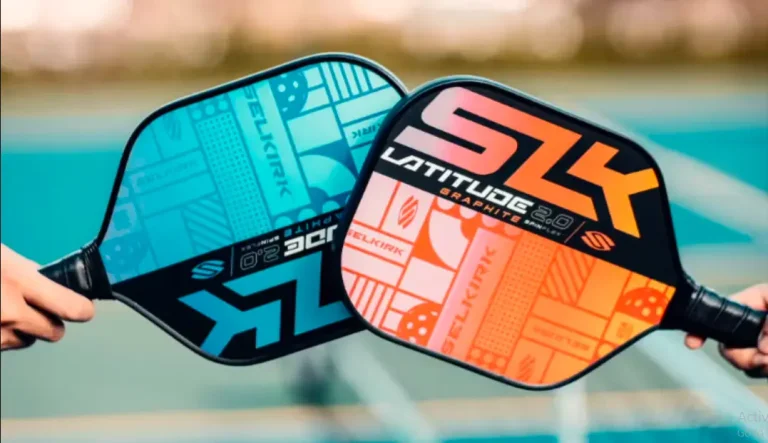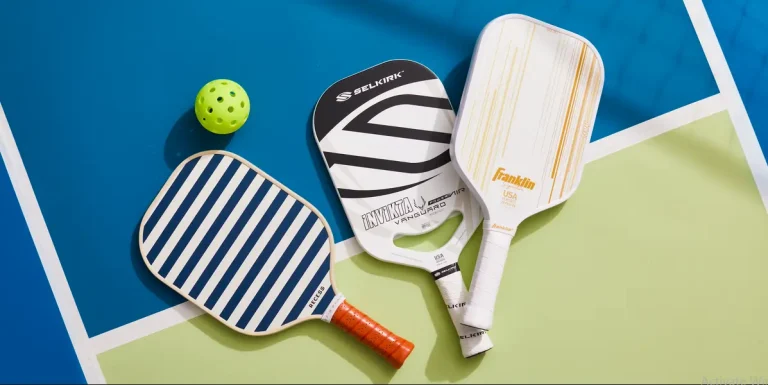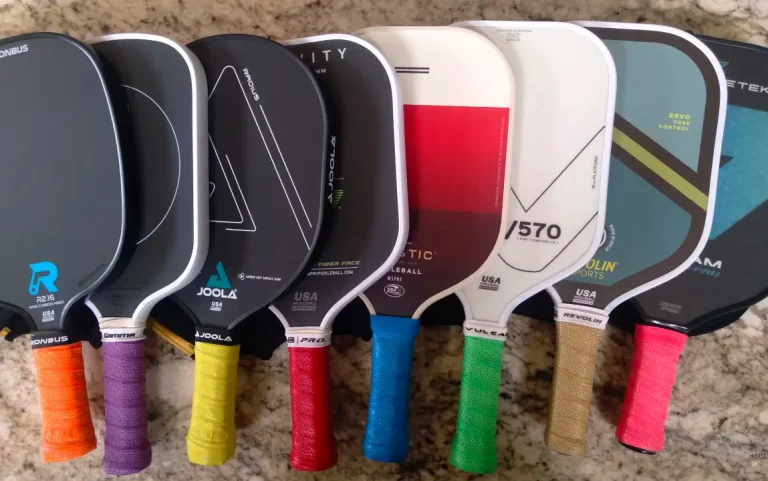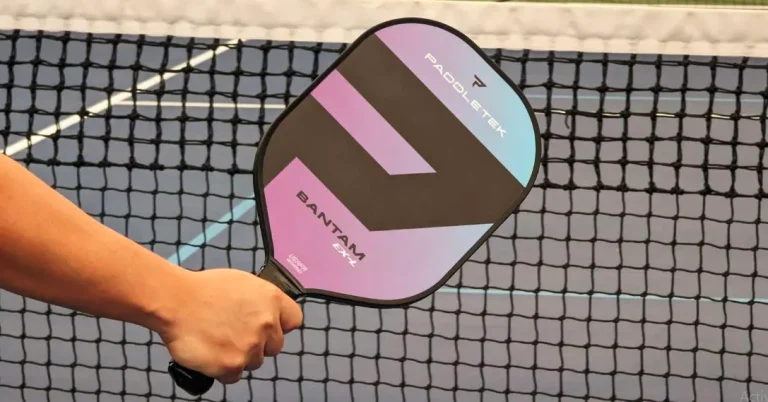The Best Beginner to Intermediate Pickleball Paddle By 2024
A pickleball shot of perfection hinges on the player’s skill and the paddle that the player uses. You can improve your performance on the court by choosing the right pickleball paddle for beginners. This is where our comprehensive pickleball paddle guide comes in, providing the scoop on the Best Beginner to Intermediate Pickleball Paddle. Aside from the fact that these paddles stand out in their quality and user-friendly designs, they also cater to various preferences and budgets and are easy to use. So, if you’re new to pickleball, check out this article to find out how you can take your game to the next level with the right paddle to help you do that.
Pickle Your Paddles
In the case of pickleball paddles, there is a size formula similar to that used by airlines. The paddle cannot be longer than 17 inches, and the paddle should have a combined length and width not exceeding 24 inches. An average paddle measures 16 inches long and 8 inches wide; however, some elongated paddles use the full 17 inches and are more potent than paddles with a wider diameter. There is no restriction on the thickness of the paddle; thin paddles can be about one-third of an inch thick, while thick paddles can be up to three-quarters of an inch wide. Pickleball paddles tend to look similar. A Joola paddle with a rounded shape reminds me of a tennis racket, and several Selkirk paddles with round faces and cutout handles minimize air resistance. A standard form is still best.
If you want the old-style paddle, the Wolfe wooden paddle is still available on Amazon. There’s undoubtedly someone who can thump you and your best player. My first paddles were inexpensive fiberglass ones. It could be six months before you upgrade from a beginner set. That said, the paddles recommended here tend to have a carbon fiber face, which is stiff and light, offering lots of pop. I also tested some graphite paddles, which are cheaper, heavier, and softer than carbon fiber. If your budget allows you to start with something other than carbon fiber, I’d recommend starting with cheap fiberglass and then jumping to carbon fiber. Note that when I mention materials, I mean what’s used for the face of the paddle—nearly all paddles have a similar honeycomb-shaped polymer core. Pricier paddles tend to cut that core in a way that creates even gaps on the edge and use heat-pressing to seal the face to the body.
Best for Beginners
For people new to pickleball, this is an excellent place to start so they can get a feel for the game without investing too much. In addition to two paddles, balls, and cooling towels, you get two paddles for $40.
I bought this set of Panel Sound paddles when I wanted to try the game with my 8-year-old daughter, who has taken four years of tennis lessons but can’t play that sport yet. I have since upgraded to other paddles, but I have no regrets about this purchase and now loan them out to other beginners. These graphite paddles don’t have a ton of pop and produce minimal spin, but they’re sturdy and have a comfortable grip. While they don’t offer a lot of power in each hit, they perform consistently. They weigh in at 8 ounces and are USA Pickleball. Approved (USAPA), meaning you can use them in a tournament. The other paddles on this list are tournament-approved, so sign up for any contest you wish to with confidence.
Best Overall
The best thing about the Omega Evolution Extreme X is how precise it feels. This paddle has a carbon fiber skin and a polymer honeycomb core with a traditional shape and a middle-of-the-road 7.7-ounce weight. The half-inch core is billed better for power, but this paddle has less pop than others on this list. Then again, power is a double-edged sword when you’re trying to land a plastic ball inside a 22-foot box.
This paddle offers excellent ball control with a large sweet spot and an impressive spin thanks to a durable textured carbon fiber surface. The edges are livelier than other paddles, meaning it’s more forgiving than many if you miss the sweet spot. If you want to hit the ball hard, you’ll need to swing hard, as this paddle doesn’t offer the kind of extra poppy drive you find on some other carbon paddles. But the tradeoff is the ability to confidently deliver a precise shot, impressing nearly everyone who tried it.
A Beginner’s Upgrade
The SLK Evo Power XL 2.0 is the paddle I bought myself from a big-box sporting goods store after playing with the cheap set off Amazon a few times. I purchased this paddle based on its excellent feel, and it still has the most comfortable grip of any paddle I’ve tried. Selkirk is one of the most popular paddle makers, and I’ve tested about a dozen different paddles from the company that were either borrowed from other players or on loan at a sponsored club.
Selkirk bills this paddle with a fiberglass face as an ideal pick for beginners and pickleball-curious tennis players. Indeed, the balanced weight distribution means it performs more like a tennis racket than any other paddle I’ve tried. That said, the Evo doesn’t offer the kind of spin you see from other paddles on this list.
For Aspiring Spin Doctors
Pickleballs are cousins to wiffle balls. If you grew up playing backyard baseball, you probably remember that the holes in the plastic balls allowed them to spin in unpredictable ways when thrown or hit correctly. The same is true of pickleball, where a skilled player with the right paddle can put a lot of spin on the ball and cause problems for an opponent. A serve with spin is so much harder to return that the game’s official rules now ban players from swirling the ball during a drop serve.
I will not claim to have mastered topspin and backspin. But the Pro XR paddle got me interested in developing the skill. The paddle is made with T700 Raw Carbon, known for producing “filthy” knuckleball-type hits with tons of spin. But the most significant difference is the unique slanted XR-23 handle, which has a 23-degree tilt at the bottom. That tilt changes your grip in a way that claims to promote hitting with spin. Everyone who tried the paddle felt a tendency to pull the ball with some spin, though it’s hard to say whether this was a direct result of their grip or just being conscious of the difference.
Best for Power Players
Joola is a relative newcomer to the pickleball game, having started as a table tennis brand. We tested a half-dozen paddles from the Maryland-based company, including a unique round frame paddle more closely modeled on a tennis racket and several from the series made for pro pickleballer Ben Johns, currently the number one ranked player in the world.
This paddle is thermoformed, meaning it’s heat-pressed together and virtually indestructible. It’s heavy on the head and delivers the most power of any paddle I tested. Everyone who tried this paddle found it more forgiving, which makes sense, given it was designed for an advanced player. The sweet spot is smaller at the top of the paddle face; it is smaller. Whack one right on the money, and the ball jolts off it. For a player without great control, it’s easy to hit too hard. However, this paddle was especially appreciated by my friend Danielle, who injured her rotator cuff a few months back and is changing how she plays.
Most Stylish
Recess pickleball paddles are known for their unmatched style—these are the prettiest paddles in the game. They come in various colorful patterns and have excellent grips with plenty of cushioning made from faux leather. They also come with an embroidered canvas cover.
A gritted fiberglass surface over the standard polymer honeycomb core does not offer the same performance as the high-end carbon fiber pickleball paddles. Recess paddles have a smaller sweet spot than some other brands. It is, however, excellent when you play a good shot with this best Beginner to Intermediate Pickleball paddle. I’ll take the satisfaction of a well-played ball hit with a stylish Recess paddle over almost anything on this list.
The Best Beginner to Intermediate Pickleball Paddle: A Buying Guide
Embarking on your pickleball journey can be exciting and confusing, especially when choosing your first paddle. Every feature, from grip size to materials, impacts your performance and game enjoyment. This comprehensive guide aims to simplify your decision-making process, shedding light on the key elements to consider when buying your first pickleball paddle.
Weight
The weight of your paddle plays a critical role in your game. Lighter paddles weighing up to seven ounces offer increased maneuverability, making it easier to control and swing the paddle. However, they might lack power. Conversely, heavier paddles weighing between eight and nine ounces give you more energy but might compromise on control. A mid-weight paddle of around 7.5 ounces for beginners usually strikes the best balance between power and control.
Materials
The racket’s material impacts its performance and durability. Wood options are affordable but heavier, making them less beginner-friendly. Composite models, made from materials like aluminum and polymer, offer a balance of power and control. Graphite paddles are lightweight and provide excellent control, but they are pricier. Composite rackets are typically recommended for beginners due to their balanced attributes.
Grip size
A paddle’s grip size can influence your comfort and control during the game. Generally, the grip size should align with your hand size. A grip that is too small can cause unnecessary wrist action and reduce power, while a grip that is too large can lead to a poor swing and possible hand strain. It’s easier to increase a grip size with tape if needed than it is to decrease it, so we recommend sizing down if you’re caught between two size choices.
Edge Guard
Edge guards offer durability and protection from ground hits. However, a more prominent edge guard can result in a higher chance of mishits, and the extra weight can affect the paddle’s balance. For beginners, a paddle with a more diminutive edge guard is typically advisable, as it reduces the possibility of mishits and improves control.
Price
Quality, not price, should be the deciding factor in your purchase. As a beginner, you don’t need an excessively expensive paddle. Instead, select a paddle that balances price and quality well. The most costly paddle won’t necessarily make you a better player. Conversely, the right paddle can significantly aid in your improvement.
Accessories
Some of the best beginner to intermediate pickleball paddles come with valuable extras or accessories such as pickleballs, protective covers, or carry bags. Consider whether you have use for these additional items to help you decide if you should purchase an individual racket or a complete pickleball set.
Conclusion
Choosing the best beginner to intermediate pickleball paddle requires considering various factors, from materials to weight and grip size. In conclusion, finding the ideal paddle often involves balancing control, power, and comfort, tailored to individual preferences and playing style. Paddles offer a more prominent sweet spot and forgiveness on mishits, which benefit beginners. Look for paddles made from durable materials like graphite or composite, as they provide a good blend of power and control. Additionally, a mid-weight paddle with a comfortable grip size can aid in maneuverability and reduce strain during extended play.







